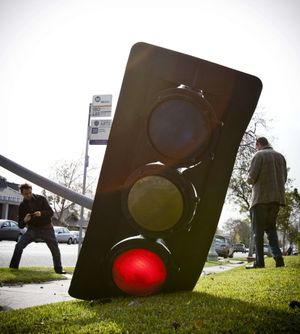Happy Birthday, traffic lights
The world's first electric traffic signals were installed in Cleveland, Ohio, 101 years ago today.
Those simple red and green lights (which were later joined by that ephemeral yellow light) may not seem like much nowadays, but they were a big deal and presaged a vast transformation in our roads.
But this simple invention marks a key moment in the largely forgotten transformation of roads during the 20th century. For most of history, roads have been chaotic, shared public spaces, packed with horses, handcarts, merchants, pedestrians, and children. As much as any other invention, the traffic signal gave rise to the carefully controlled, highly automated thoroughfares we think of as roads today.
See?
Vox also shared an early film taken from the front of a streetcar moving down San Francisco's Market Street. Cars, carriages, cyclists, pedestrians and streetcars mix in disharmony and I'm sure fender benders, or whatever they called them back then, were quite common. In short, turn-of-the-century San Francisco streets were pure chaos, which is how streets were back then.
And, I would be remiss if I didn't talk about the latest technology: Red light cameras. And that's all I'll say because just mentioning the words rings the bells of those lost in a red-light fever dream where Big Brother tends to his treasures by sending fines to light-running scofflaws.
But it was the rationalization of the street intersection, the high modernism of designing the urban environment using scientific laws, where traffic signals really made a difference.
Again, from Vox:
A huge range of inventions and policies — from the concept of jaywalking to the controlled-access highway — were crucial in this transformation. But the traffic signal came at a particularly pivotal time.
During the 1910s, when electric traffic lights first popped up, cars were still a plaything for the rich. When drivers ran over pedestrians, they were publicly portrayed as murderers. For a brief moment, many felt that automobiles were inherently deadly machines, with no place on city streets.
If police departments, engineers, and auto enthusiasts hadn't figured out a way to minimize the carnage, that might never have changed. But they managed to do so, by forcing pedestrians to use crosswalks, writing rules to standardize the flow of traffic, and, crucially, regulating activity at intersections, where a disproportionate amount of accidents occurred.
During the 1920s, cars steadily began to filter down to the middle class, eventually becoming mainstream — and traffic signals became commonplace in most large American cities.

